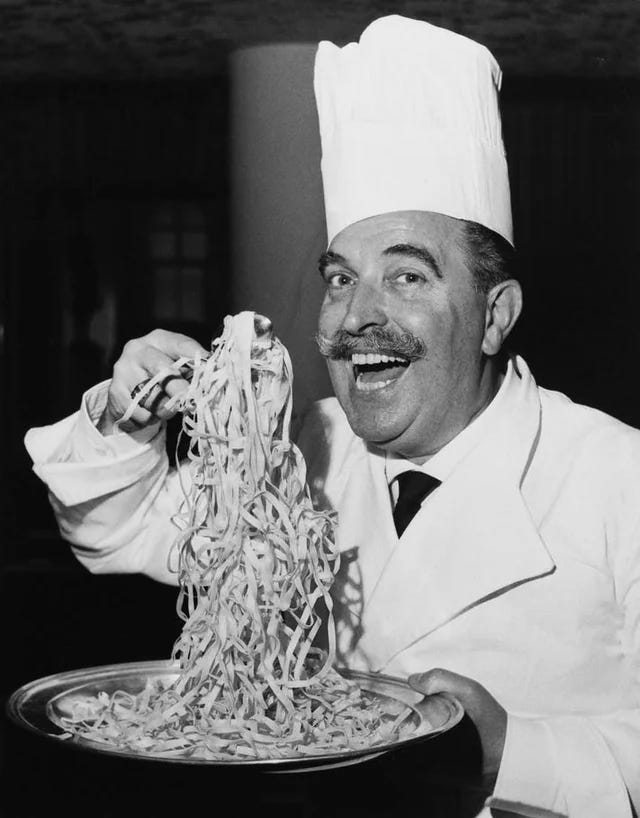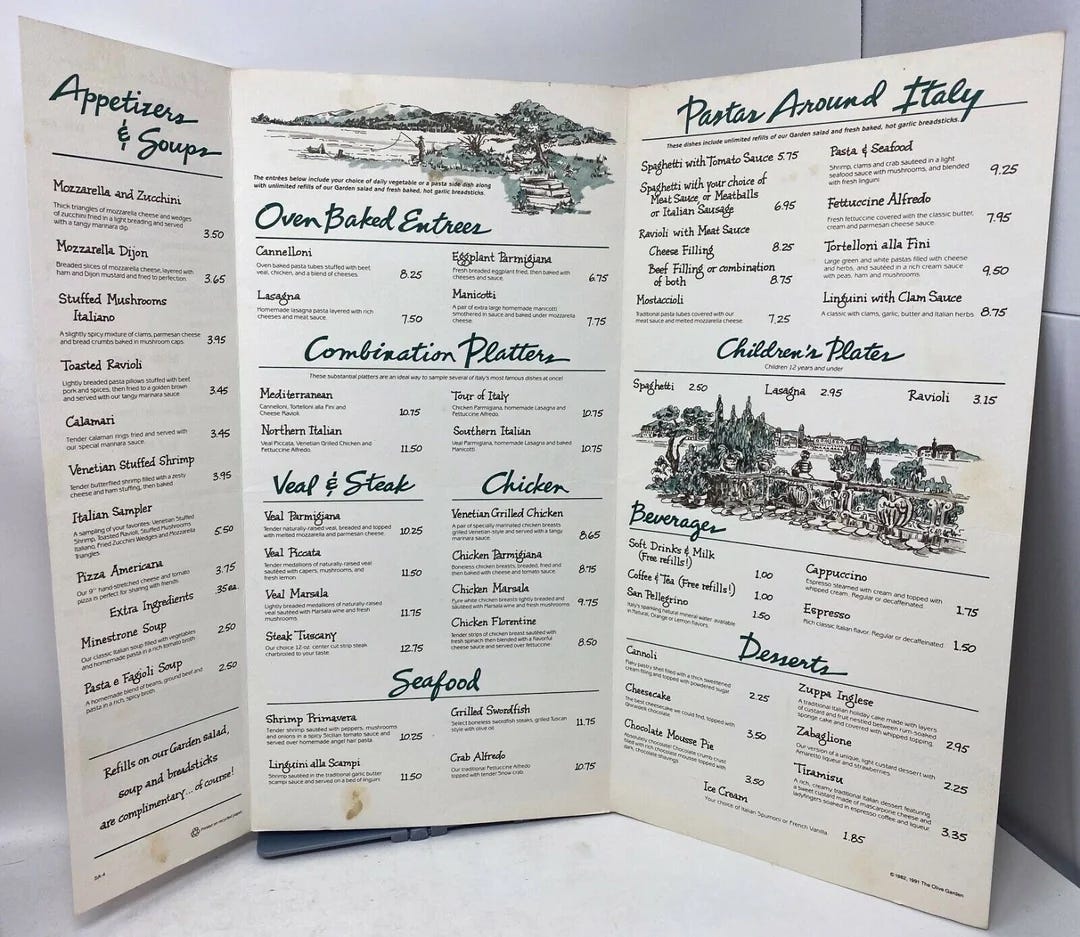Italian food is so deeply woven into US culture that some classic Italian dishes like pizza are starting to be considered as American food in their own right. But while many recipes evolved through Italian immigration to America, Fettuccine Alfredo has an even more surprising story.
Coming from the UK, I've always known that Fettuccine Alfredo never appears on European menus — it's a special American treat I only enjoy when visiting the States. But I’d never really thought about why this might be. Having spent a fair bit of time in Italy over the years, I was instinctually aware that Alfredo was different to the sorts of pastas I was used to finding in Italy, even without added chicken or prawns (according to one of my Italian friends, chicken in pasta or on pizza is horrifying).
So perhaps I shouldn't have been so surprised to discover that Fettuccine Alfredo wasn’t really an Italian dish brought to America by Italian immigrants at all—but by Americans themselves (and not just any Americans, actual movie stars!)
The original Alfredo
The story goes that the original Alfredo sauce was made by Alfredo de Lelio in Rome in the early 20th century to help his wife gain her strength back after giving birth to their son. His original creation was a variation of a traditional pasta dish with butter and cheese (pasta al burro) but made with even more butter than usual, trying to encourage his wife to eat and put on some weight. His wife loved it and it was soon being served at his restaurant, Alfredo’s.
In 1920 Mary Pickford and Douglas Fairbanks, Hollywood’s power couple of the time, honeymooned in Rome and supposedly ate frequently at Alfredo’s, taking a particular shine to his pasta with butter and parmesan. Apparently they served the recipe to friends when back in the States, making it a popular dish among their Hollywood crowd.
But although this story is very charming, it doesn’t quite explain to me how the dish became such an icon, even with their considerable star power. When researching the history of Alfredo sauce, this story was basically all I found, but this doesn’t explain what came next. How did Fettuccine Alfredo become one of the most well-known and popular pasta dishes in America over the next 60 years?
What next?
In the first half of the 20th century recipes weren’t commonly written down, particularly among the Italian American community who were used to learning recipes from family members by word of mouth. There are some references to Alfredo sauce in restaurant reviews, novels describing high society visits to Rome and the occasional recipe, but none of these really document the process of Fettuccine Alfredo’s development to include cream or become as popular as it is today.
By the 1960s when convenience foods were starting to become more common, a packet of Pennsylvania Dutch egg noodles included a recipe for Alfredo on their packaging. It’s super interesting to me that the first packet recipe was included on essentially an ethnically German company’s packaging. It shows that the recipe was reaching new audiences, possibly because it was comforting and familiar to other European cultures who also had a history of egg noodles mixed with dairy products.
As well as parmesan and butter, the Pennsylvania Dutch packet also called for Swiss cheese and cream. This was advantageous both because the parmesan available in the US was not as good as the Parmigiano Reggiano available in Italy, but also because the cream made it substantially easier to make the dish. Creating a smooth sauce with just butter and cheese is harder than it seems - the pasta needs to be warm enough to allow the ingredients to melt and emulsify smoothly, but not so hot that it causes the cheese to become grainy and lumpy. The final dish would also need to be eaten immediately to avoid it becoming too thick, but a cream based sauce is more flexible and can hang around slightly longer before being eaten. It’s also possible that the cream based sauce was more similar to traditional Pennsylvania Dutch noodle dishes.
A cream based sauce is also possible to manufacture, jar and sell to the end consumer in a way that wouldn’t be possible with just butter and cheese. As convenience food continued to grow in popularity through the second half of the 20th century, jarred Alfredo sauces were increasingly manufactured along with dried pasta and sauce mixes.
In the UK if you go into a supermarket to buy jarred pasta sauce, you’ll probably find various tomato options and usually at least one cheese based white sauce. This is referred to as a cheese sauce, white lasagna sauce, or a carbonara sauce. There’s always a white sauce option, but there’s no consistency on what it might be called. From my (admittedly brief) time buying groceries in the US, it seems like the white sauce option is always marketed as an Alfredo sauce. It’s a conveniently standard way to tell the consumer what is in the jar, without pretending that it’s all cheese. It’s also much easier and more appealing to tell your family that you’re having fettuccine Alfredo for dinner than pasta with white lasagna sauce.
But as well as home cooks, restaurants also helped cement Fettuccine Alfredo as a staple Italian American dish. One of the earliest mentions of Fettuccine Alfredo in print is a review of a restaurant in Manhattan in the NYT from 1957, which doesn’t specify what the sauce is, showing that it was well known enough to not require clarification for the reader. Alfredo di Lelio himself opened a restaurant in New York in 1977 and McDonald’s offered Fettuccine Alfredo on their short-lived dinner menu in the late 70s. But potentially most famous for fake Italian food, Olive Garden opened in 1982 and capitalised on the growing popularity of Italian food. While sadly I couldn’t find a menu from quite that far back, by the 1990s Fettuccine Alfredo was one of Olive Garden’s few pasta offerings (along with an entire veal section on the menu).
These days, Alfredo is coming full circle. Travel influencers are flocking to the original Alfredo’s in Rome, posting videos of pasta being tossed in butter and parmesan at their tables. Before researching this article I’d probably have rolled my eyes at American tourists seeking out a real Roman version of an American dish, but since Alfredo di Lelio loved serving American tourists in the 1920s and his sauce seems to pre-date carbonara, maybe this is actually one of the most authentic pasta experiences in Rome?
Time to make my own
Recipes for Fettuccine Alfredo are also coming full circle, with many modern recipes not using cream at all, instead just calling for butter and parmesan. To give the dish a fair try, I decided that the most authentic way I could approach my taste testing was to do one creamy version, one pasta al burro version and try some jarred sauce.
I was most excited about the creamy version, so started with that, using this Joshua Weissman recipe. The finished dish was very garlicy, but much less heavy and sickly than versions that I’ve had in restaurants. It was easy to make and even though I accidentally added the cheese while cream was still very hot this wasn’t a problem for the texture of the sauce. While he gives weight measurements in the video, he didn’t in the written recipe and I ended up accidentally using much less parmesan than suggested, so I’ll have to give it another go at some point.
Given I’d enjoyed the creamy version, I also decided to give Joshua’s Fettuccine al Burro a go too. This version required a lot more technique to get the butter, pasta water and parmesan to emulsify, and I didn’t manage to get the parmesan to melt completely into the sauce. I can totally see why the creamy version became more popular as the texture was definitely nicer, and overall it was a lot less salty (although maybe actually using the recommended amount of parmesan was a bit of a shock to my system).
Finally I decided to head to the other end of the difficulty spectrum and try three jarred Alfredo sauces. I picked up jars from Rao’s, Trader Joe’s and a pesto version from Whole Foods, which I thought would be fun. (It wasn’t).
The Rao’s was the only one that didn’t taste artificial and actually tasted like the real deal (which I’d bloody well hope so given it was almost $9 a jar). The Trader Joe’s sauce was much cheaper at $3.49, but sadly tasted it. It was a lot more artificial and less cheesy tasting. And finally the Whole Foods Pesto Alfredo, the unmitigated failure of the test. The pesto flavour was extremely bitter, the sauce was very runny and it was outright unpleasant to eat. Not fun. I’d buy the Rao’s again, but by the time you’re paying $9 a jar you might as well buy all the ingredients and just make it.
There really is an Alfredo for every occasion. Will it become a staple for me? I’m not sure. It does tick most of my usual boxes for a go to weeknight meal, but because it’s all dairy it’s a heavier dinner than I’d usually go for during the week. At the weekend if I’m in the mood for cooking I usually want to make something more elaborate than pasta in a cream sauce. But I can 100% see how this would be a staple for fussy children or on a cold rainy winter’s evening. Maybe I’ll lean into it later on in the year, but as we head into summer I’ve eaten more than enough Alfredo for now.
Although Fettuccine Alfredo is probably the most American in origin of the dishes I’ve written about so far, it’s interestingly the only one that is still seen as Italian rather than just American. It’s clear that there’s a deep connection to Italy in the US, in particular in New York, that I’m looking forward to exploring more. Just maybe in a less creamy way next time.






